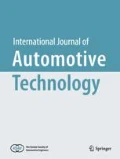Abstract
To reduce the aerodynamic drag, the performance of the underbody aerodynamic drag reduction devices was evaluated based on the actual shape of a sedan-type vehicle. An undercover, under-fin, and side air dam were used as the underbody aerodynamic drag reduction devices. In addition, the effects of the interactions based on the combination of the aerodynamic drag reduction devices were investigated. A commercial sedan-type vehicle was selected as a reference model and its shape was modeled in detail. Aerodynamic drag was analyzed by computational fluid dynamics at a general driving speed on highway of 120 km/h. The undercover reduced the slipstream area through the attenuation of the longitudinal vortex pair by enhancing the up-wash of underflow, thereby reducing the aerodynamic drag by 8.4 %. The under-fin and side air dam showed no reduction in aerodynamic drag when they were solely attached to the actual complex shape of the underbody. Simple aggregation of the effects of aerodynamic drag reduction by the individual device did not provide the accurate performance of the combined aerodynamic drag reduction devices. An additional aerodynamic drag reduction of 2.1 % on average was obtained compared to the expected drag reduction, which was due to the synergy effect of the combination.
Similar content being viewed by others
References
ANSYS, Inc. (2010). ANSYS. Fluent 13.0 User’s Guide.
Buchheim, R., Leie, B. and Luckoff, H. J. (1983). Der Neue Audi 100-Ein Beispiel für Konsequente Aerodynamische Personenwagen-Entwicklung. ATZ, 85, 419–425.
Cogotti, A. (1989). A strategy for optimum surveys of passenger-car flow fields. SAE Paper No. 890374.
Dubief, Y. and Delcayre, F. (2000). On coherent-vortex identification in turbulence. J. Turbulence, 1, 1–22.
Heft, A., Indinger, T. and Adams, N. (2012). Introduction of a new realistic generic car model for aerodynamic investigations. SAE Paper No. 2012-01-0168.
Hu, X., Zhang, R., Ye, J., Yan, X. and Zhao, Z. (2011). Influence of different diffuser angle on Sedan’s aerodynamic characteristics. Proc. Int. Conf. Physics Science and Technology, 239–245.
Hucho, W. H. (1998). Aerodynamics of Road Vehicles. 4th edn. SAE International. Warrendale, Pennsylvania, USA.
Huminic, A. and Huminic, G. (2012). Numerical flow simulation for a generic vehicle body on wheels with variable underbody diffuser. SAE Paper No. 2012-01-0172.
Kang, S., Cho, J., Jun, S., Park, H., Song, K., Kim, K. and Lee, D. (2012). A study of an active rear diffuser device for aerodynamic drag reduction of automobiles. SAE Paper No. 2012-01-0173.
Kim, T. K., Choi, J. K., Kim, J. H., Cho, J. H., Lee, Y. B., Kim, K. H., Lee, D. H., Kim, J. P. and Lee, J. H. (2012). Numerical simulation of flows and aerodynamic drag with active air flap in 3-dimensional engine room. Spring Conf. Proc., Korean Society of Automotive Engineers, 452–462.
Kim, T. K., Jeong, S. M., Choi, J. K., Kim, K. H., Kim, J. P. and Lee, J. Y. (2013a). Parametric study of aerodynamic drag reduction devices for aerodynamic drag reduction of sedan (1): Undercover and under fin. Spring Conf. Proc., Korean Society of Automotive Engineers, 1500–1508.
Kim, T. K., Jeong, S. M., Choi, J. K., Kim, K. H., Kim, J. P. and Kim, K. Y. (2013b). Parametric study of aerodynamic drag reduction devices for aerodynamic drag reduction of sedan (2): Side air dam. Spring Conf. Proc., Korean Society of Automotive Engineers, 1509–1518.
Kumar, A., Singh, A. and Regin, A. F. (2015). Study on effect of ground clearance on performance of aerodynamic drag reduction devices for passenger vehicle using CFD simulations. SAE Paper No. 2015-26-0197.
Kwak, M., Lee, Y., Kwon, H., Kim, K. and Lee, D. H. (2013). Optimum nose shape of a front-rear symmetric train for the reduction of the total aerodynamic drag. J. Mechanical Science and Technology 27, 12, 3733–3743.
Le Good, G. M., Passmore, M. A. and Cogotti, A. (1998). A comparison of on-road aerodynamic drag measurements with wind tunnel data from Pininfarina and MIRA. SAE Paper No. 980394.
Levin, J. and Rigdal, R. (2011). Aerodynamic Analysis of Drag Reduction Devises on the Underbody for SAAB 9-3 by Using CFD. M. S. Thesis. Chalmers University of Technology. Gothenburg, Sweden.
Marklund, J., Lofdahl, L., Danielsson, H. and Olsson, G. (2013). Performance of an automotive under-body diffuser applied to a sedan and a wagon vehicle. SAE Paper No. 2013-01-0952.
Mellios, G., Hausberger, S., Keller, M., Samaras, C., Ntziachristos, L., Dilara, P. and Fontaras, G. (2011). Parameterisation of Fuel Consumption and CO2 Emissions of Passenger Cars and Light Commercial Vehicles for Modelling Purposes. Publications Office of the European Union. Luxembourg.
Mock, P., Kühlwein, J., Tietge, U., Franco, V., Bandivadekar, A. and German, J. (2014). The WLTP: How a new test procedure for cars will affect fuel consumption values in the EU. Int. Council on Clean Transportation. Working Paper 2014-9, 1–20.
Nakamura, D., Onishi, Y. and Takehara, Y. (2015). Flow field analysis in the development of the 2013 model year accord hybrid. SAE Paper No. 2015-01-1534.
Oh, K. T., Kim, J. H., Lee, S. W., Kim, Y. S., Ha, J. W. and Kang, W. K. (2007). Automobile underhood thermal and air flow simulation using CFD. J. Computational Fluids Engineering 12, 1, 22–27.
Rogers, S. E. and Kwak, D. (1990). An upwind differencing scheme for the time-accurate incompressible Navier-Stokes equations. AIAA Journal 28, 2, 253–262.
Sapnaras, D. and Dimitriou, I. (2008). Experimental analysis of the underbody pressure distribution of a series vehicle on the road and in the wind tunnel. SAE Paper No. 2008-01-0802
Singh, S. N., Rai, L., Puri, P. and Bhatnagar, A. (2005). Effect of moving surface on the aerodynamic drag of road vehicles. Proc. Institution of Mechanical Engineers, Part D: J. Automobile Engineering 219, 2, 127–134.
Author information
Authors and Affiliations
Corresponding author
Rights and permissions
About this article
Cite this article
Cho, J., Kim, TK., Kim, KH. et al. Comparative investigation on the aerodynamic effects of combined use of underbody drag reduction devices applied to real sedan. Int.J Automot. Technol. 18, 959–971 (2017). https://doi.org/10.1007/s12239-017-0094-5
Received:
Revised:
Accepted:
Published:
Issue Date:
DOI: https://doi.org/10.1007/s12239-017-0094-5




